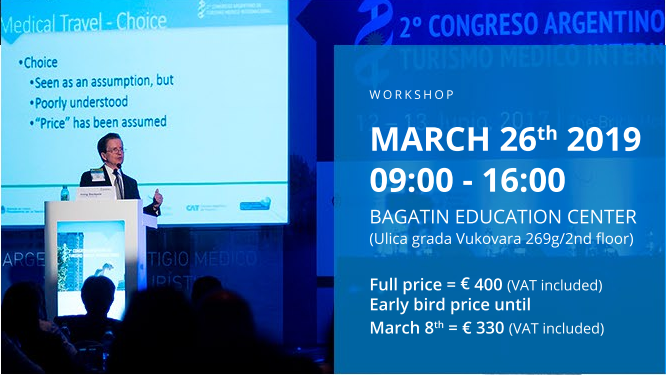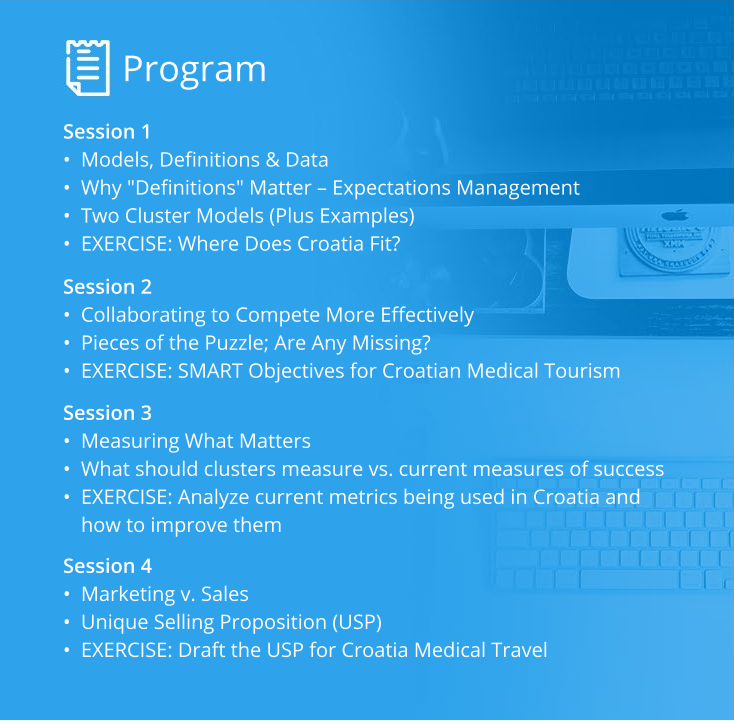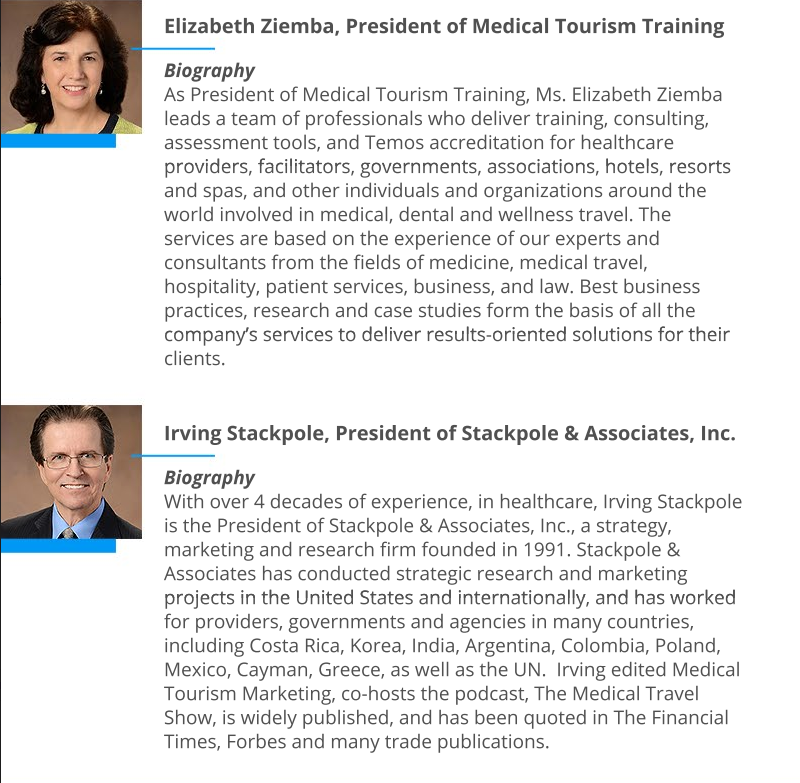Dinamo Zagreb Appoints First Woman President of Management Board
A woman will lead Dinamo Zagreb for the first time in the club’s history.
Burning Dollars in Zagreb: From Cancelled Conferences to Health Tourism Reports
March 5, 2019 - Last month it emerged that the Zagreb Tourist Board spent 29,000 euro on a tourism conference which disappeared. This month's story looks at a US$50,000 investment in a health strategy document. Oh dear.
I love living in Croatia, I really do. And as I have written previously, life in The Beautiful Croatia is addictive, and I genuinely don't think I could live anywhere else; a little like malaria, once Croatia gets under your skin, there is no escape.
It used to be a blissful and happy existence, living on an idyllic Dalmatian island and blogging about happy tourism stories all day over a cold one in a cafe on the main square.
And then I started a national news portal, and I started to understand how Croatia really works. Looking back, I can't believe how naive I was, or how much different the reality is to the worlds that most expats here move in. Croatia changed for me, but the change only sucked me in deeper. I wrote about the change some time ago - A Tale of Two Croatias: Before and After the Uhljeb Discovery.
And the more I learned about the corruption and how Croatia really works, the more shocked I became. My Croatian friends were laughing at me, enjoying my progress of discovery of the realities of life here. They still are, as every day brings something new.
Being the first daily Croatian news site with Google News accreditation meant that I had inadvertently got into something larger than planned. Suddenly I realised that TCN had the potential to be a window to the international community to showcase stories which were not about tourism and the endless sunshine. I got my first taste of this when we did the scandalous story of The Sun's investigative 'journalist' who went overland from Istanbul to Paris, via Croatia, without being asked to show his passport once.
After the then Croatian Minister of the Interior posted proof online that not only had he been checked on entry from Serbia, but that he had exited Croatia with a flight from Zagreb to Paris, TCN did the story. Hardly the intrepid overland journey. Our English version of the story went global, with my editorial quoted in Huffington Post and The Sun removing the article and stating that it had changed its freelance hiring practices.
With a growing readership of the Zagreb diplomatic community, EU institutions, international media and businesses working in Croatia, perhaps we could even make a difference, I thought. More Croatian laughter, this time over lunch with a Croatian media friend, who dampened my expectations of what I could achieve. A national name, my friend has uncovered several stories of corruption and incompetence over the years.
"There is no point. Nothing will change. Nobody cares. You can do brilliant work and - apart from professional pride at a job well done - it really doesn't matter."
And - sadly - he is right.
Last month, in collaboration with Goran Rihelj from HR Turizam, we told the story of the cancelled CETS tourism conference, and how organisers Andy and Lu Buchanan disappeared with 45,000 of money from the Croatian National and Zagreb tourist boards. When adding all the other payments from would-be exhibitors, the number is probably closer to 200,000 euro. All they left in their wake was a disabled website, lots of unpaid bills, and a recently formed company in Spain with a startup capital of just 3,000 euro.
I was actually surprised at how much media attention the story received, with the Zagreb tourist board director even appearing on the national news to explain what happened. And then, once the Facebook shares and comments subsided, the story died a death.
As it always does in Croatia. No accountability. No consequences.
"It wasn't even a story," my media friend said. "With all the other stuff going on here, I am surprised at the amount of coverage."
Followers of TCN will have noted that we are taking a greater interest in medical tourism in recent times. Like most other people in the country, I had no idea that Croatia had such world-class private healthcare, or the potential to be in the world's top ten. My journey of discovery started 18 months ago when I wrote a feature story on three of the biggest names - Bagatin Clinic, Svjetlost Eye Clinic and St Catherine Specialty Hospital - which led to Health Tourism is Coming Home: Why Zagreb is the Next Big Medical Tourism Destination.
My journey of discovery took me to conferences in Crikvenica and Zagreb, wellness centres in Krapinske Toplice, clinics in Split, and interviews with some of the biggest names in the medical tourism industry - Keith Pollard, Editor in Chief of International Medical Travel Journal, Sherene Azli, CEO of the Malaysia Healthcare Travel Council, and global speakers such as Ilan Geva and Dr Prem Jagyasi. All of them in Croatia helping the emerging medical tourism story. And they all said the same thing - Croatian has the potential to be in the top ten medical tourism destinations in the world in 10 years, if only all the stakeholders can come together.
The economic benefits, and the year-round tourism that medical tourism can bring, are plain to see. If Croatia really could be in the world's top ten in such a growth industry, surely this should be a priority to develop, with a national strategy including stakeholders all singing from the same hymn sheet. But the more I looked at the industry, the more I saw how disorganised it was, with a few trailblazing clinics going their own way. International speakers told me that the Kvarner Health Cluster was better known as a health destination than Croatia itself (well done, Team Kvarner), and Team Malaysia talked of their hashtag #WeWinTogether and how the ONLY strategy can be to build the national brand first and go from there.
It would not be correct to state that official bodies are not investing in medical tourism. They are. A speaker from the national tourism board told a conference I attended in Crikvenica that they had invested 4 million kuna, without giving any specifics. And then I heard stories from various sources that the Zagreb Tourist Board had invested 100,000 euro into a health tourism strategy document for Zagreb (when I asked for confirmation, I was told that the actual amount was US$50,000). While it seemed a little insane to me to do a feasibility study just on one city and not the whole country while the national tourist board was spending millions of kuna on another strategy (#WeWinTogether), at least it was progress.
Or so I thought.
Until I read the report, all 71 pages of it, full of shiny charts and lots of data, much of it with little relevance to Zagreb. And having read it twice, I am still trying to find the strategy.
Fifty thousand dollars.
Even before we sit down to read this enlightening document (parts of which I doubt were written by a native speaker due to numerous spelling and grammatical errors), the first alarm bell went off when looking at some of the shiny charts. I would like to publish examples here, but reproduction without permission is strictly prohibited, so you can take a look for yourself. Several of the charts have a copyright of 2017-8, while citing another copyrighted source dating back to 2015. So, for our fifty thousand dollars, we are being treated to data which is four years old.
Not only that, but once you start reading, there are other gems to behold. Did you know, for example, that in 2014, 28 million Italians holidayed overnight abroad? Great data from five years ago. Or that in 2015, Visa revealed that German households spent $74.4 on travel? Four years ago.
Fifty thousand dollars.
The impression I had on reading this document is that it had some quite useful general data on the global health tourism industry, most of which was barely relevant to Zagreb. The section on penetrating the US market is a classic example. More than two pages of statistics and facts are given over to the American market. The recommended strategy (this is what you get for $50,000) seems to be that Zagreb has good affordable healthcare and it should market that to American tourists and also make direct contact with American companies.
That's it.
And the sad thing is, the report misses out completely on the biggest opportunity Croatia has from the North American market - its diaspora.
As Professor Nikica Gabric, founder of the pioneering Svjetlost Eye Clinic, said in the video above:
"What we should do first is let Croats who live around the world know about the quality and potential of health tourism in Croatia. And then the Croatian diaspora will be the best ambassadors in their communities to explain that in addition to being a beautiful and safe country, they can get quality medical care for significantly less money."
The love for the homeland is real, and the Croatian diaspora has been sending back billions over the years, and many are very willing to buy Croatian any time they can. So much so in fact that last week we reported on the fact that Croatian diaspora remittances are now bigger than foreign investment in Croatia - some two billion euro.
There are an estimated 1.2 million Croatian diaspora in the United States, about 40% of the global Croatian diaspora and the source of a large chunk of that 2 billion.
It is something that the Zagreb Tourist Board seems to be unaware of. Apart from a passing reference to the diaspora in Germany, I could not find any inclusion of the diaspora as part of the strategy. Having read the report, I sent some questions to the Zagreb Tourist Board, which they were kind enough to answer. I asked about the lack of diaspora focus in the document.
"Our diaspora is mostly located in targeted countries such as Germany, Austria, Slovenia and Italy."
Really?
There are an estimated 3 million people in the Croatian diaspora. According to figures published a few years ago, here are the top 6 counties:
- United States 1 200 000
- Germany 350 000
- Argentina 250 000
- Australia 250 000
- Canada 250,000
- Chile 200 000
About 2.15 million people, 70% of the diaspora, which last year sent back 2 billion euro, but not a target group for incoming health tourism, despite the fact that many come on holiday to Croatia every year and do not have to be targeted as the non-diaspora American market.
Surely, as Professor Gabric states, the diaspora is the place to start. Not only with their own treatment, but talking to friends in the pubs of Dublin, Munich and Stockholm, about how Croatia is a fantastic tourist destination where you can pay for your holiday with medical tourism savings.
So what are the target countries identified? Slovenia, Italy, Austria, Germany, Russia, the United States, and the United Arab Emirates.
Not the UK? I was surprised at the omission. I was even more surprised when I read some of the info in the report. Apparently about 6% of Brits go to Croatia already for dental treatment, so the market is already there and just needs to be developed. Croatia is increasingly popular with Brits and only two hours away. There is a culture of heading to this part of the world for dental and other healthcare treatment from the UK. So much so, the report itself notes, that Hungary generated $600 million from dental tourism back in 2008. If Hungary can do it, why can't Croatia - Keith Pollard told me that Croatia could take 25% of that market if it got organised. The Zagreb report even has statistics on who is going for treatment. Of the 60,000 dental tourists annually, 23,500 are British, followed by Austria (16,000) and Germany (13,500).
But the UK is not a target market for Zagreb.
The report talks about the importance of Zagreb Airport. It also explains how other countries partner with the national airline, to provide discounts for health tourists to the country - 50% from Turkish Airlines for example. Malaysia also has a dedicated medical tourism arrivals hall at its airports. So it was something of a surprise in the report when I got to another shiny chart listing all the stakeholders who should be involved in developing Zagreb's health tourism strategy.
Croatia Airlines and Zagreb Airport did not make the list - they are not stakeholders in developing Zagreb's medical tourism strategy.
There are lots of charts, all beautifully presented. One of my favourites is a price comparison for certain medical procedures - very useful. Except that the price comparison is limited to just three countries - Croatia, UK and Italy. Quite why the UK is included if it is not a target country is an interesting question, but not as interesting as why there is no data to compare with the countries which are targeted.
Fifty thousand dollars.
The only firm conclusion I took away from this report was the recommendation to form a central coordinating body called ZAMTO to move Zagreb medical tourism forward. No sh!t, Sherlock, why didn't we think of that?
I asked the Zagreb Tourist Board if they had learned anything from the report, and if so, what?
"Having international partner gives us more objective approach, we find especially interesting SWOT analysis of current situation regarding the health tourism in Zagreb and Croatia."
Q. Apart from the fairly obvious point that a central coordinating body (ZAMTO) should be formed to promote medical tourism, the report was very light on concrete suggestions. What other concrete suggestions and recommendations did the study have?
A.Creating central coordinating body (ZAMTO) is highly valuable insight and we believe that creation is just one small step in making the organization work since its role should be to bring together the key stakeholders.
Hmmm.
I asked several industry professionals if they had read the report and if yes, what had they learned. There was a consensus.
Absolutely nothing.
I could go on about the omission of Zagreb's strengths (it has 3 of the top 6 dermatology clinics in Europe, or it is the only place in Europe which is offering the new Mayo Clinic co-founded pharmacogenetic test), but I fear I might lose you.
There was just one more question to ask the Zagreb Tourist Board:
Q. In terms of value for money for the Croatian taxpayer and Zagreb Tourism Board, how would you rate this report out of ten?
A. We would give a high rate for this report, although Croatian taxpayers did not participate in it, since ZTB budget is derived from the membership fees and tourist tax.
So all is well then.
Ha, my media friend just arrived.
"You are wasting your time, nothing will change."
"I know."
"Do you feel better for writing it at least?"
"Not really."
"Oh. Well let's go for a beer."
To follow the latest in the Croatian medical tourism story, follow our dedicated page.
Developing Croatian Health Tourism: Irving Stackpole & Elizabeth Ziemba Zagreb Workshop
March 4, 2019 - More international expertise is arriving to help the development of the Croatian medical tourism industry, as Bagatin Education Center announces another niche seminar.
And still they keep on coming...
It is now about 18 months since I first discovered the huge potential of medical tourism in Croatia, writing my first article on the subject after visits to Bagatin Clinic, Svjetlost Eye Hospital and St Catherine Specialty Hospital. Those visits opened my eyes and culminated in Health Tourism is Coming Home: Why Zagreb is the Next Big Medical Tourism Destination.
Since then, the story - and the potential - has only got more interesting, and after I wrote 25 things to know about health tourism in Croatia, I realised that here was a real treasure that was largely untapped.
I attended a couple of health tourism conferences last year to broaden my education, and I was amazed at the wealth of international speakers who were coming to Croatia to talk about health tourism. Even better for TCN, they were all very happy to speak to me about the position fo health tourism in Croatia and its potential. Keith Pollard, Editor-in-Chief of the International Medical Travel Journal; Sherene Azli, CEO of the Malasia Healthcare Travel Council; global branding expert Ilan Geva and global speaker Dr Prem Jagyasi. All in Croatia - all highly respected in their particular field.
The conclusions were the same - Croatia has the potential to be in the world's top ten in the medical tourism industry, if officials can unite and push the industry forward on a united front, a topic we looked at in depth, as well as the fine example of the Malaysian model to follow.
It was meeting branding guru Ilan Geva that opened my eyes just a little further. For while all the medical tourism conferences are very high profile (and the next one of note is the 5th Annual Medical Tourism Conference in Zagreb on March 13-14 by Euro Events with another world-class lineup), I met Geva at a very specialised seminar on the branding of Croatia as a medical tourism destination. There were just 15 people there, all key stakeholders in the industry (myself excepted), a very intense and productive session organised by Bagatin Clinic. You can read more about it here.
So while the increasing number of health tourism conferences are raising the profile of Croatia as a medical destination, there is a second level of education and institution building, which is being conducted largely off the public radar. Much of this is being organised by Bagatin Clinic, which is very aggressively (in the nicest possible sense of the world) pioneering the industry's international profile. By bringing the key local stakeholders together and connecting them with experts such as Geva, the boutique Bagatin seminars are strengthening existing connections and forging new ones.
And the promotion and education continues...
Next up at the Bagatin Education Centre are two more international industry heavyweights, who are introduced by Bagatin, above, better than I could do myself - Elizabeth Ziemba, President of Medical Tourism Training, and Irving Stackpole, President of Stackpole & Associates.
The title of the one-day seminar is Taking Cluster Development to the Next Level: Changing the Course of Medical Travel. It will be one more part of the learning process for me. Tickets are limited and can be reserved through Bagatin Clinic.
For more on the Croatian health tourism story, follow our dedicated page.
Snapshots of Zagreb as a New Business Opens in a Pretty Courtyard
March 4, 2019 - One of the great charms of the old towns of Croatia is are the secrets behind every corner, as I discovered with the opening of Break Time Zagreb.
Croatia has some incredible history, and the number of ancient buildings is breathtaking. So too, are the number of surprises which await you around every corner, alley and courtyard.
Take last week for example. A trip down to Split for the opening of the Bagatin Clinic had a colleague and I sharing a room in the old town close around Diocletian's Palace. My colleague suggested the room as he had something he wanted to show me. At 20 euro for the night, I was not going to argue, and we went to an unassuming address and entered an equally unassuming room. Nothing too spectacular so far.
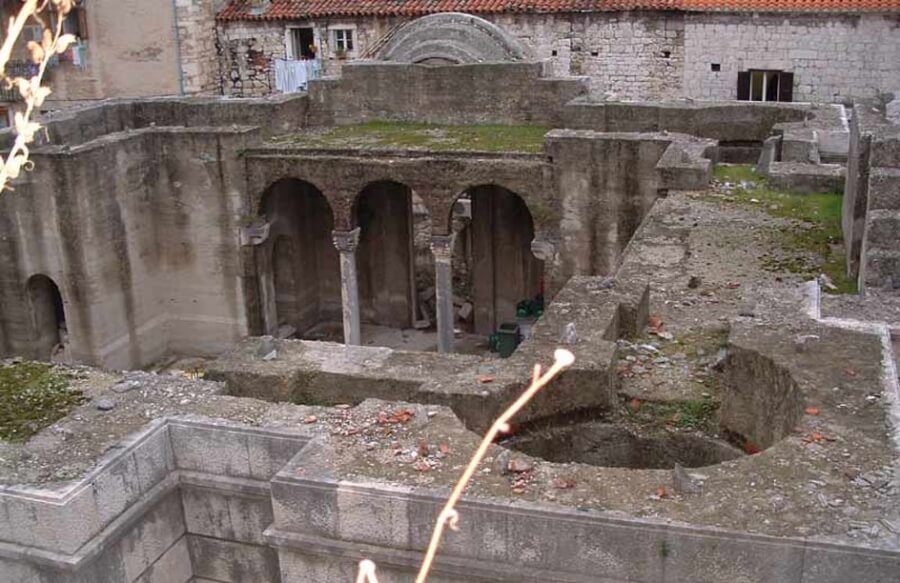
"And you also have use of the terrace," said the landlady before leaving.
And what a terrace it was! For there in the middle of a very spacious courtyard with no public access whatsoever was the remains of a half-constructed historical building, one I had never heard of. I consulted the man, who knows everything about Split, the excellent guide Ivica Profaca, who was surprised at my lack of knowledge.
"It was supposed to be a Serb Orthodox church, but it was never finished. Some chap called Ivica Profaca wrote an article about it for a site called Total Croatia News a few years back."
Ah.
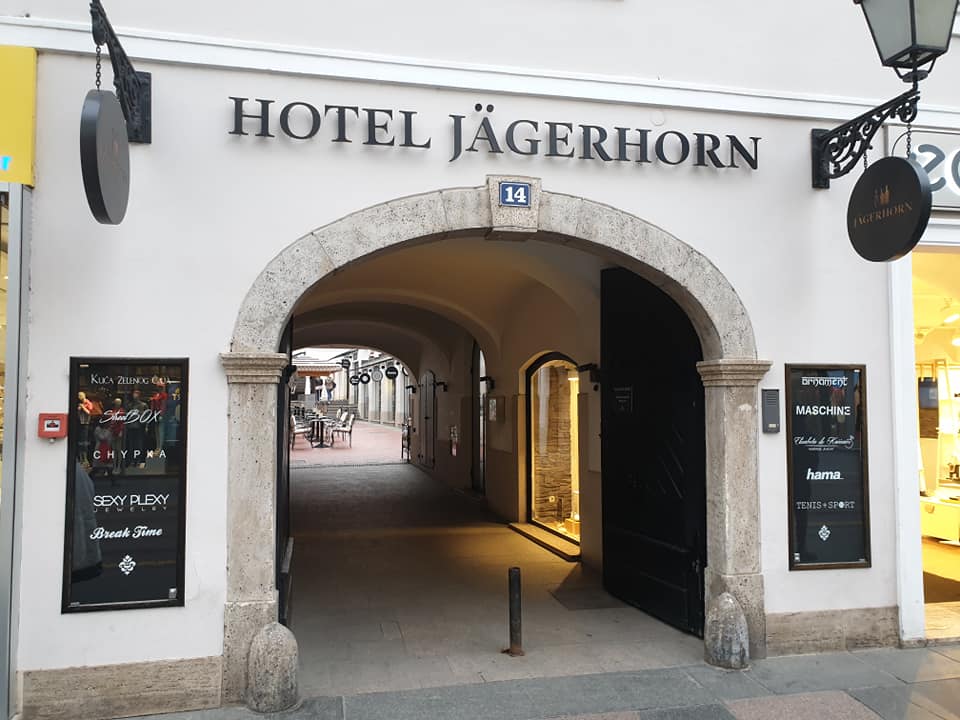
Fast forward a week and I found myself in Zagreb on business, but wanting also to pop in to say hello to Romanian friends who were opening their fifth store in four years in Croatia. The guys from Break Time nautical bracelets are a real inspiration to many, proving that you CAN come to Croatia and succeed as a foreign entrepreneur. Here is an earlier TCN interview with Mirela on that very subject.
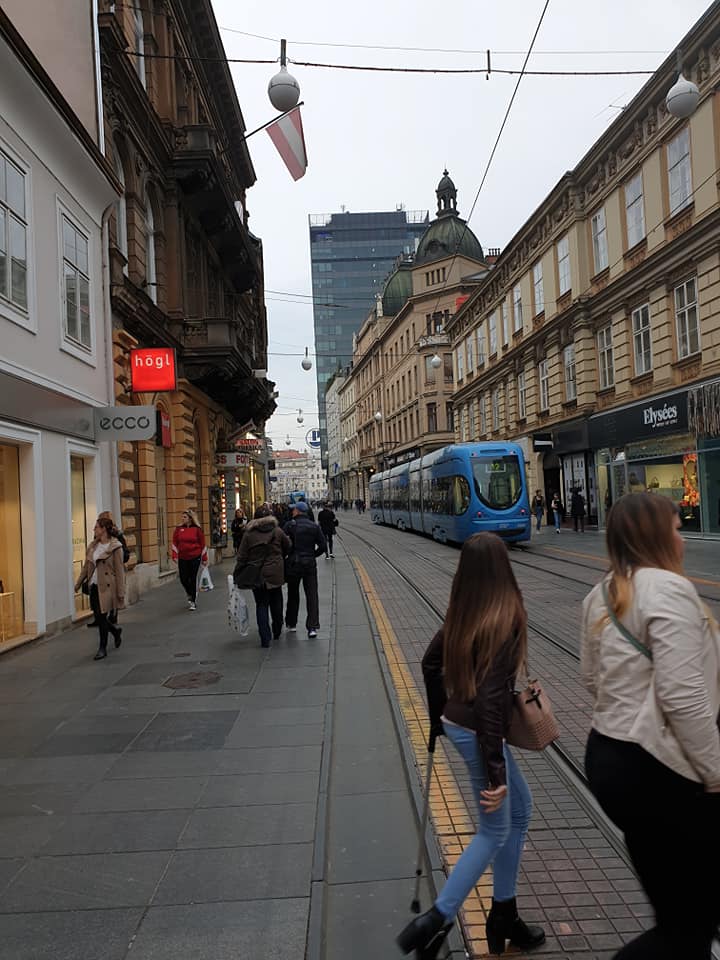
Ilica 14 was the address, just two minutes from the main Ban Jelacic Square, and yet not somewhere I would normally find myself wandering. Looking for the shop, I came across a rather impressive entrance, home to Hotel Jagerhorn, which I was told was the oldest hotel in the capital.
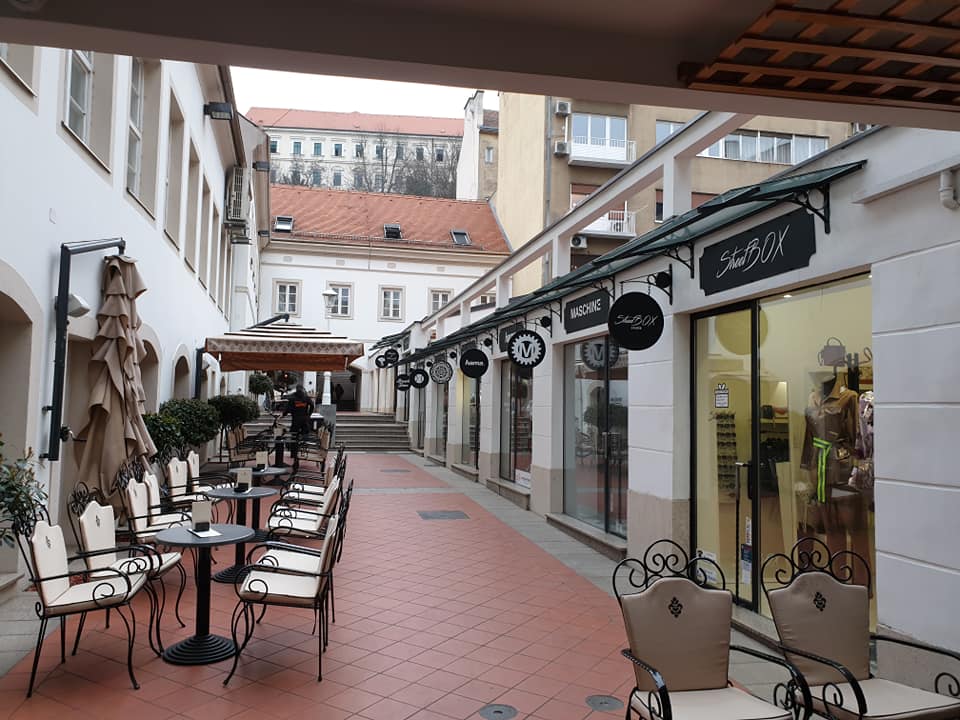
Entering the courtyard under through the impressive arch on Ilica was a delightful little courtyard called Lovacki Rog, The Hunter's Horn, a very pleasant spot with a couple of cafes and several boutique shops.
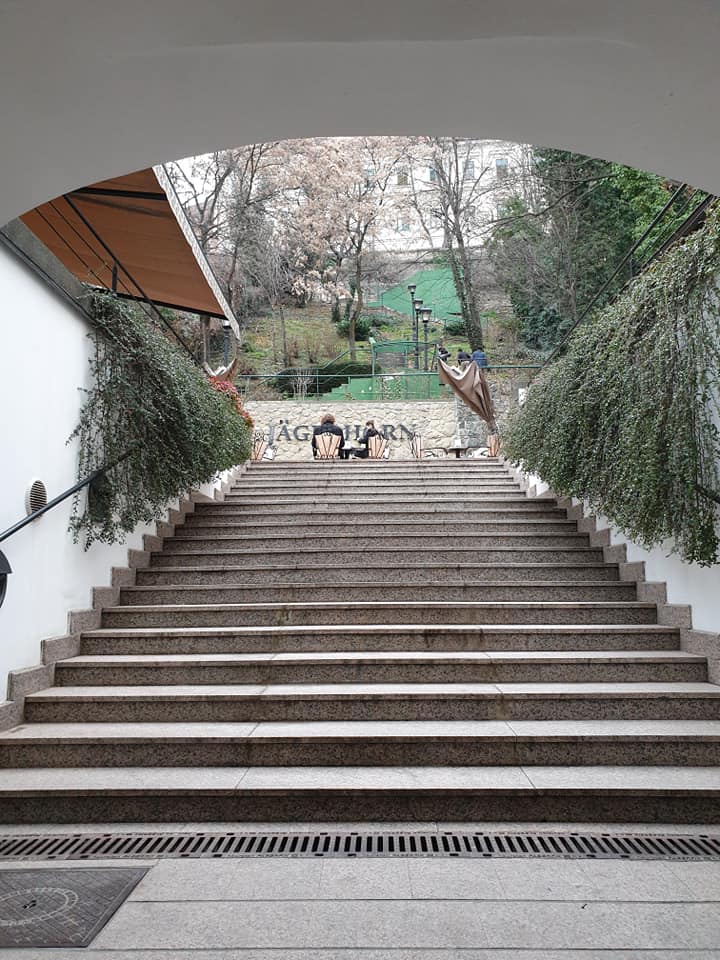
And then, when I walked through, I remembered that I had been here before, the imposing steps to Upper Zagreb await those who want to continue through the courtyard.
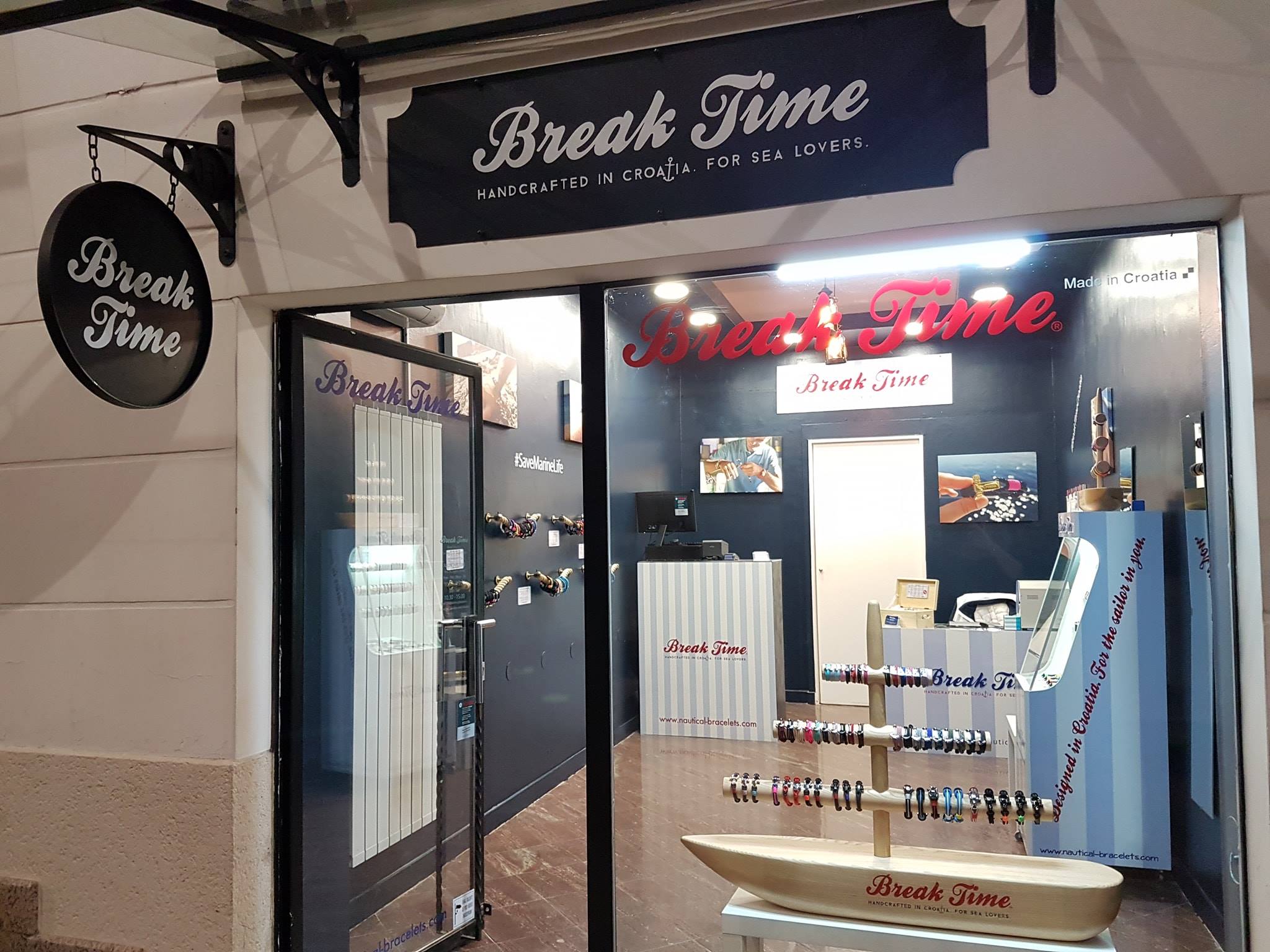
But what a pretty little courtyard, and one where the local businesses were made to keep to certain rules. In order to preserve the authenticity, signage is restricted to black and white, and the effect works very well. A nice collection of stores and the cafes also looked very pleasant.
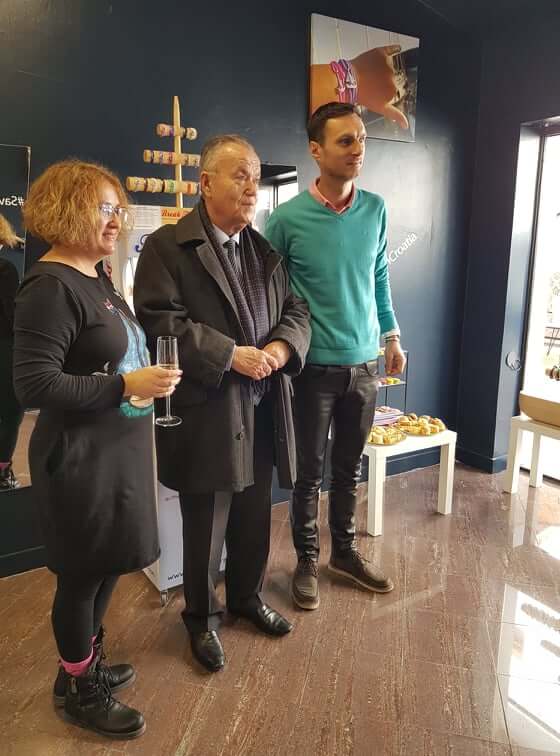
As for the Break Time Zagreb opening, it was a busy day, as Mirela told me when we popped in:
"We have been looking for the perfect location for a Break Time shop in Zagreb for almost two years, and we are now happy that we did. We love the vibe of the Jagerhorn passage, we love that we are just opposite Cvjetni Trg and just 30 seconds away from Trg Bana Jelacica. And in regard to our opening day, we were overwhelmed by the love and support we got from the media and also from our Zagreb fans. We got to meet quite a few in person today and it was nice to put a face to a name we only saw on Facebook or Instagram while they were liking our posts. We also got so many messages on social media from people that were happy we are finally in Zagreb and they can actually see our jewellery and not have to order just online. And last, but not least, we were very honoured by the presence of H.E. Constantin Grigorie, the Romanian Ambassador in Croatia, who came to wish us luck."
They are - to their knowledge - the only 100% Romanian-owned company in Croatia.
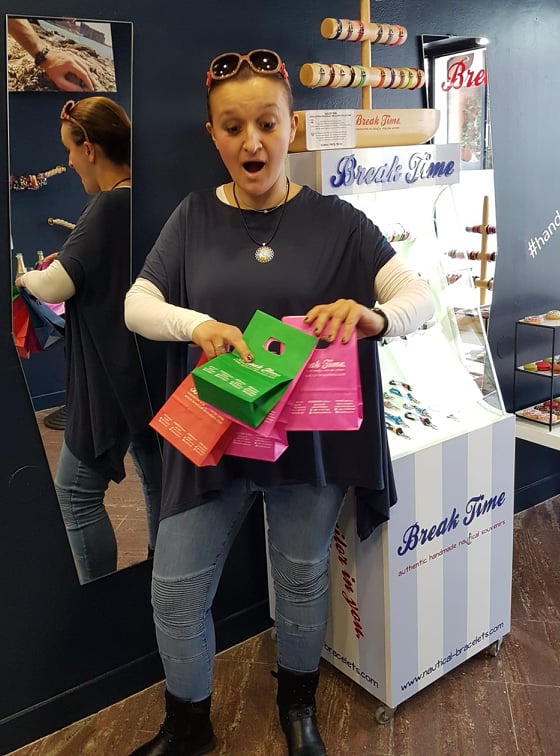
And business was brisk on the first day, with Ruzica, above, the star customer, taking home no less than 8 bracelets.
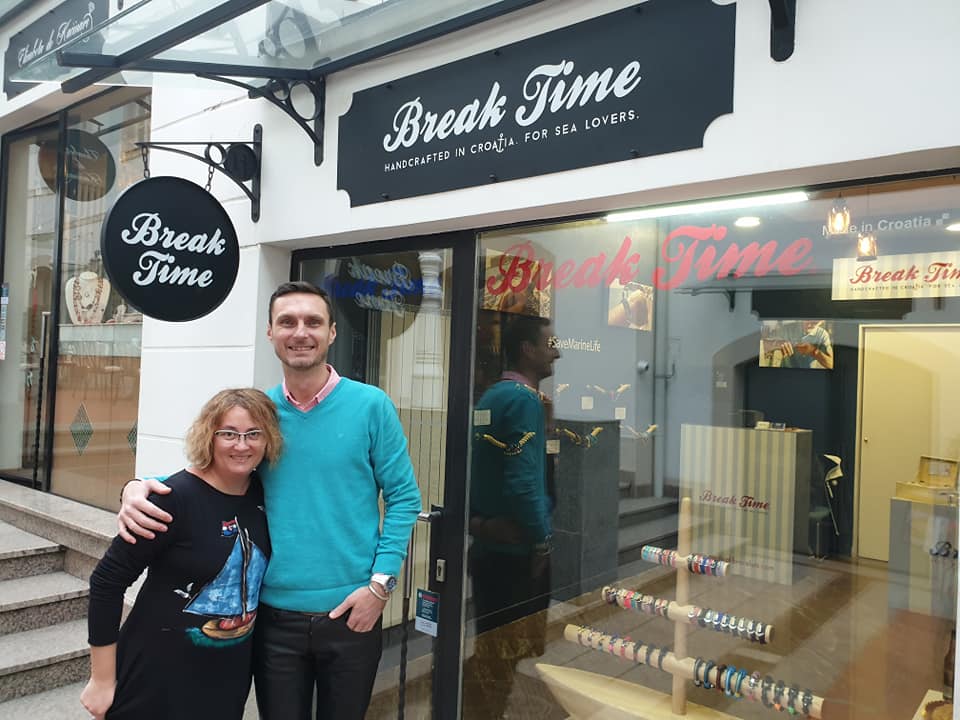
A nice little entrepreneurial success story tucked away in a picturesque Zagreb courtyard.
So next time you are wandering around an old town in Croatia, follow your curiosity - you never know what you might find.
To learn more about Break Time nautical jewellery, visit the official website.
HNL Round 23 Recap: Wins for Hajduk and Rijeka, Draws for Dinamo and Osijek
March 4, 2019 - The Croatian First League’s 23rd round saw Hajduk, Rijeka and Gorica win, while Dinamo and Osijek pulled draws over the weekend.
Chinese Documentary "Up the Mountain" Wins Big Stamp of ZagrebDox
ZAGREB, March 3, 2019 - The Big Stamp for best film in International Competition of the 15th edition of the international documentary film festival ZagrebDox went to the Chinese documentary "Up the Mountain" by Yang Zhang, according to the decision of the jury of the festival which ended on Saturday.
The Chinese documentary is about an artist originally from Shanghai, has been living in a small, remote village in Yunnan Province with his family for many years. and his apprentice Dinglong who decides to move to the city.
The Big Stamp for best regional film went to the film titled "Una Primavera" by Valentina Primavera, and this Italian documentary is about Fiorella, a mother of three, who decides to leave her husband, their house and life to free herself after 40 years of marriage.
The audience declared the Croatian documentary "Neighbours" by Tomislav Žaja the best film of the latest festival edition. The author has shot an observational documentary about people with psychological difficulties who leave the institution after decades spent in isolation, subsequently trying to put back together the pieces of their broken lives.
More film news can be found in the Lifestyle section.
Cro Cop Recalls Student Days in Zagreb, Working as Security Guard, and Red Nikes
March 3, 2019 - After news broke on Saturday that Croatian MMA fighter Cro Cop, or Mirko Filipović, was forced to retire from the ring after suffering a stroke, the outpour of support and praise for the celebrated fighter has not come to a halt.
The MMA legend has been showered with stories by fighters and friends in the last 24 hours, which has brought true gems to the surface from Filipović’s early days as a student in Zagreb, long before he embarked on his magnificent 25-year-career, reports 24 Sata on March 3, 2019.
Some of you might be aware that the student dorm Stjepan Radić in Zagreb is the most famous home in Croatia; a place where generations and generations of students spend their university days. It is where you party, learn, socialize and enjoy the benefits of student life.
But not many people know that at the Sava, which is the popular nickname for the great dorm, lived the strongest man in Croatia. Yes, you guessed it, Mirko Filipović.
Namely, Cro Cop came to the Sava in 1994, with 400 marks in his pocket given to him by his mother. He spent a year there and lived illegally while working on the side to survive.
Four years ago, Mirko visited his old home and gave a lecture to the students. The legendary Kino Forum was not big enough to host all of the curious ears. About 400 people packed the small room to listen to Filipović speak.
“At that time, I worked as a security guard and attended the Police Academy. My first roommate looked like Kurt Cobain, and then I got a second roommate that was the complete opposite. That room was cleaned day and night. On one occasion I returned from work at 3 or 4 in the morning and found him cleaning the windows. I liked it,” said Cro Cop, who lived in the 7th Pavilion, in room 22.
"Of course I like him. I've been watching him fight for a long time. I think of him as a positive person and an excellent fighter, his left high kick will be recorded in history,” says Ivan, who has lived near Mirko’s old room for years.
The students love Mirko, because of his personality, and because of his modesty - he came from nothing and introduced himself to the martial arts world as a big star. Of course, the students diligently followed his fights, and everyone is devastated to hear that he's been forced into early retirement.
“His first match I saw was in 2008 when he defeated Japan's Mizuno, and definitely the favorite match is the win against Gonzaga in the return match. Goodness, how he broke him. I'm sorry he had to go this way because I know he is a fighter in the heart, but health has no mercy. The most important thing is that everything went well. He achieved ten wins in a row, so he went out like a hero,” added the student.
Student life on the Sava is most famous for going out and hanging out. Student Wednesday, for example, is an event that never goes missed - students are quite innovative. In their small rooms of 13 m2, they are known to cram up to 20 people!
Mirko, however, did not like going out because he was diligently training at the time he lived in the dorms.
“I do not drink alcohol. And then I did not like going out, just like now. I just think it's a waste of time. I train on Friday and Saturday, so I prefer to rest,” said Cro Cop.
One of the most famous anecdotes associated with Mirko and Sava are his red sneakers.
The Croatian fighter lived in the dorms, worked as a security guard and earned a living. His great wish was a beautiful pair of Nike sneakers he finally managed to afford. However, living on the ground floor of a student dorm had its disadvantages.
“I bought beautiful red Nike sneakers. And put them on the window, just naive. The next morning they were gone. I thought that maybe they fell, but no, no. One of the toughest moments of my stay at the Sava,” Mirko said with laughter.
"If I could return to those days with this mind now, I would do it right away. I would not change anything; everything would be the same. I just want to repeat that period,” Cro Cro Cop said as nostalgia for past times overcame him.
This was just the beginning for the greatest Croatian fighter. Only two years later, in 1996, Mirko had his first fight when he defeated the legendary Le Banner.
The Sava still has the strongest man in Croatia.
To read more about sport in Croatia, follow TCN’s dedicated page.
Old Steam Mill to Be Turned into Zagreb City Library
The UPI-2M architectural studio, best known for designing the Arena sports halls in Zagreb, has won the first prize at the competition for the architectural proposal for the new Zagreb city library at Paromlin (old steam mill), reports Večernji List on March 2, 2019.
As announced yesterday by the Zagreb Architects Society (DAZ), twenty proposals were submitted to the competition that was published last October, and the jury selected the top five. The UPI-2M project was voted as the best, and the eight-member team will receive 271,040 kuna.
“By analysing the wider and narrower area around Paromlin, we have addressed the question of how to design a city library complex that should take into account the strict conservative regulations which protect the Paromlin buildings as a site of a highly-valuable industrial architecture monument,” said the studio, adding that the organic form of the new part the city library building would be in contrast with the strict lines and the volumes of the existing and protected Paromlin buildings.
For this reason, the facade of the new part would reflect the surrounding components of the complex, the warehouses for flour and silos, as well as the surrounding park which would, according to architects, dematerialise its own volume.
“In the existing Paromlin buildings we plan to accommodate the administrative parts of the library, while the new building and its levels from -1 to +2 would house public facilities, i.e. entrance hall with a conference room, department for children and youth, reading rooms for collections and magazines, music department with a public roof terrace,” explained the UPI-2M studio, adding that the -2 level is reserved for technical areas and the public garage space.
The reconstruction of Paromlin will cost around 300 million kuna, and the new city library will not be constructed until at least 2025. The funding for the project, as announced by the city authorities, should at least partly be provided from the European Union funds.
Translated from Večernji List (reported by Mateja Šobak).
More Zagreb news can be found in the dedicated section.
Meet Croatia's Health Tourism Providers: 2. St Catherine Specialty Hospital
March 1, 2019 - As Croatia looks to develop its medical tourism industry, TCN continues its look at the key health tourism providers. This week, St Catherine Specialty Hospital.
Several months ago, I was invited to a press conference at St Catherine Specialty Hospital. TCN gets invited to a lot of press conferences, but we rarely attend due to time and limited resources. But there was something a little different about this invitation, and as I was planning to be in Zagreb that day, I decided to attend.
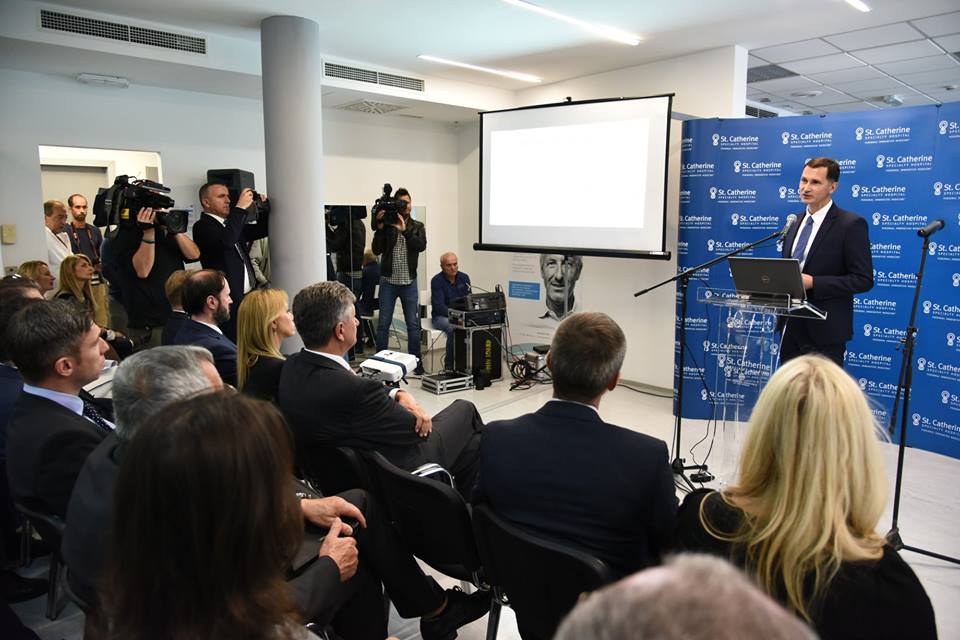
(Prof dr.sc. Dragan Primorac at the OneOme press conference in Zagreb)
I was blown away.
For two reasons.
The first reason I was blown away was what was being announced.
Healthcare is not a topic I know a great deal about, but even I could see that the unveiling of the new OneOme RightMed pharmacogenetic test which had been developed in cooperation with Mayo Clinic in the States was a potential game-changer in global and personalised healthcare.
I learned that the fourth-largest killer in the United States each year was due to adverse drug reaction (ADR), more than 100,000 people a year. The prescribing of drugs which have little or no effect also costs over $100 billion a year. A drug which works for one patient may not work for another, and slower metabolisms also differentiate the speed with which medicines work on patients. The policy of blanket prescribing for all is both costly, ineffective and deadly. If only there was a way to personalise the diagnosis of a patient's needs.
Enter OneOme. The RightMed pharmacogenetic test does exactly that. After a simple swab OneOme processes the sample and generates the RightMed test report. Finally, you visit a clinic representative who helps you understand the test results. Depending on your genes, your body may break down a drug too slowly or too quickly. If you metabolise a drug too slowly, you may be exposed to too much of it, which may result in an adverse drug reaction (ADR). If you metabolise a drug too quickly, you may not get enough to have any effect at all. A OneOme RightMed test helps to identify this for your doctors.
A Mayo Clinic trial of 3,600 patients whose RightMed information was available to doctors led to a 30% reduction in hospitalisation of heart patients.
The potential saving to national healthcare systems is mind-boggling. You can learn more about OneOme in this interview with Prof. dr. sc. Dragan Primorac of St Catherine Specialty Hospital.
The second reason I was blown away was that the first partner chosen to provide the OneOme RightMed test in Europe was St Catherine Specialty Hospital in Croatia.
Yes, tiny Croatia, at the forefront of cutting edge medical innovation. I was stunned.
Stunned is an emotion I have encountered a lot since I discovered the emerging medical tourism story 18 months ago. I visited three of the country's top private healthcare providers (Bagatin Clinic and Svjetlost were the others) as part of my research, and this led to my first visit to the St Catherine Zagreb facility. What I found at all three facilities was a level of customer care that far exceeded the perception of healthcare in Croatia. You can read my first article of discovery - Health Tourism is Coming Home - Why Zagreb is the Next Big Medical Tourism destination.
A member of the Leading Hospitals of the World, the OneOme press release introduced St Catherine as follows:
St. Catherine is a university teaching hospital and the official hospital of the Croatian Olympic Committee and of the Croatian Football Federation. The Hospital is the first European recipient of U.S. Global Healthcare Accreditation and known for introducing the integrative concept of personalized medicine in clinical practice.
I was soon to learn that St Catherine Specialty Hospital is so much more than that, as the official St Catherine website explains:
St. Catherine Hospital is a proud member of the prestigious group "The Leading Hospitals of The World", while In June, 2015., The International Certification Association (ICERTIAS) announced that the St. Catherine Hospital won the top-Quality medal (QUDAL - QUality meDAL) along with award of St. Catherine Hospital being the best private hospital in the Republic of Croatia, which is all according to the customer’s/patient’s opinion and judgement. It is also worth mentioning how during the studies, the ICERTIAS was using CAWI – DEEPMA (Computer Assisted Web Interviewing – Deep Mind Awareness) methods in order to analyze and examine all the received data.
St. Catherine Specialty Hospital’s membership in the International ICERTIAS Customers’ Friend programme – “Because we care about our customers”, attests to the special care and attention that Specialty Hospital give to patients and their problems, as well their commitment towards developing long-term customer satisfaction from the very beginning – from the first phone call up to the final phase of treatment.
Nevertheless, the "Super-brands organization" based in Great Britain (since 1995), has proclaimed St. Catherine in July 2016, as one of the strongest and the most successful brands in that year, thus, along with that, St. Catherine won “Croatia Superbrands 2016 Award” regarding its quality, reliability and distinction.
On November 6th, 2015., Ministry of Science, Education and Sports of the Republic of Croatia announced that the St. Catherine Hospital become “Scientific Center of Excellence for the Personalized Medicine in the Republic of Croatia” as a part of Consortium that includes the top healthcare and scientific institutions in the country and such field.
In April 2017, St. Catherine was awarded the “Best Hospital Award” for the strong position at the national market and in international sector ratings, successful implementation of modern management technologies, staff excellence and the efficient marketing strategy. Mrs Jadranka Primorac, M.Sc., Board Member of St. Catherine Specialty Hospital was honoured as a “Manager of the Year” by the Europe Business Assembly, Oxford, UK.
In April 2017 St. Catherine hospital has won a major international medical tourism award for their efforts in attracting international patients to Croatia. St. Catherine Specialty Hospital was named “International specialist patient centre of the year" by medical travel publication the International Medical Travel Journal Medical Travel Awards 2017 at their annual awards ceremony, the IMTJ Medical Travel Awards 2017.
In May 2017, St. Catherine Specialty Hospital was selected among the top 10 European companies in the category of 'The Award for Customer Focus' at the European Bussines Awards, for its business success and excellence, innovation and ethics in business. St. Catherine Specialty Hospital has been selected among 34,000 businesses that have been involved in this prestigious competition. Also, St. Catherine Specialty Hospital has won the status of the "National Champion for the Republic of Croatia in The European Business Awards".
The main hospital is a short drive from Zagreb in the town of Zabok. I took my daughter there for treatment and was amazed at the size of it in gorgeous and spacious grounds. St Catherine treats 35,000 patients a year, and after years in the Croatian public healthcare system, it was a totally different experience altogether, both in the diagnosis and the customer care.
Croatia has its poster child heroes in various sectors of society who can compete on the world stage in their fields, such as Mate Rimac and Luka Modric. Add St Catherine Specialty Hospital to that list in the field of medical tourism.
To learn more about St Catherine Specialty Hospital, visit the official website.
To learn more about the Croatian medical tourism story, follow the dedicated TCN page.
Croatia Receives Two New Michelin Stars!
Croatia now boasts five restaurants with Michelin stars!

